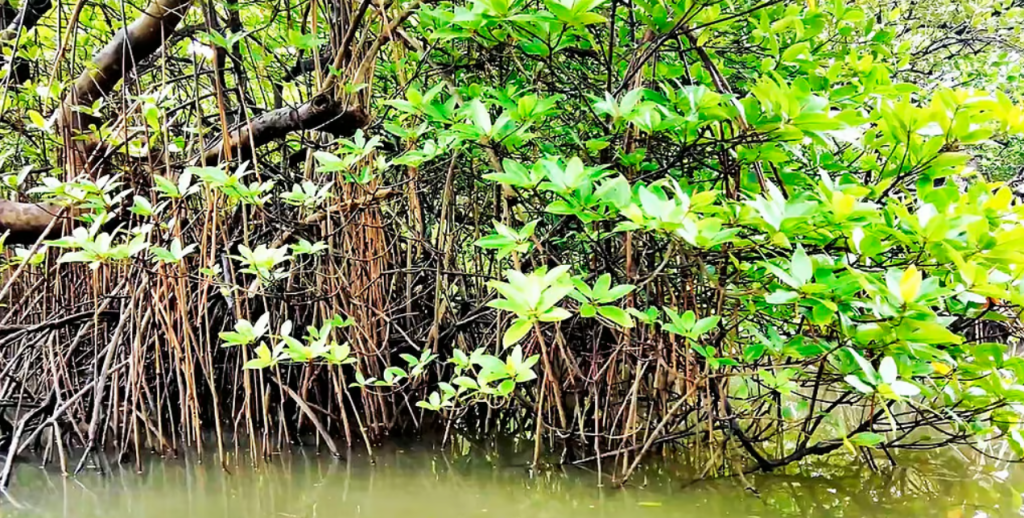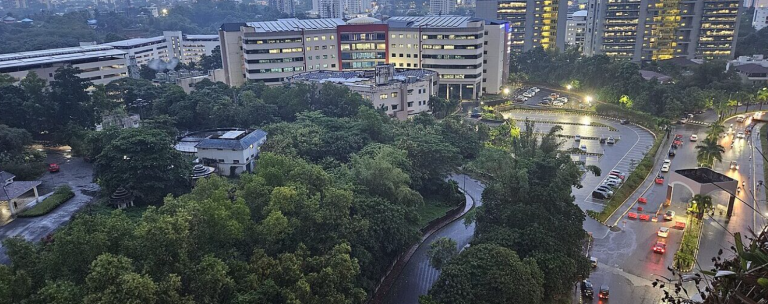The world’s mangroves, sea grasses and salt marshes together comprise ‘blue carbon ecosystems.’ They are nature’s most effective carbon sinks.
Current studies suggest that mangroves and coastal wetlands annually sequester carbon at a rate 10 times greater than mature tropical forests. They also store three to five times more carbon per equivalent area than tropical forests, as per the article Coastal Blue Carbons, by the National Oceanic and Atmospheric Administration (NOAA).
A report titled Blue Carbon and its role in Carbon Sequestration by Bhavesh Choudhary published in June 2024 revealed that mangroves alone have the capacity to store more than 1,000 tons of carbon per hectare.
As per the Partnerships in Environmental Management for the Seas of East Asia (PEMSEA), just 10 per cent of degraded mangroves restored worldwide could sequester an extra 1.6 billion tons.
The mangroves are more than just carbon sponges. Their roots help prevent soil erosion and keep the soil stable, while increasing and providing a home for marine life, as per a report by the United Nations Environmental Program (UNEP), titled Surging Seas published in August, 2024.
Policy and economic bottlenecks
Notwithstanding their promise, systemic hurdles often delay the development of blue carbon projects. A report titled Mangroves of Myanmar by Christoph Zöckler, published in August 2019 revealed that Myanmar has lost a significant portion of its mangrove forests, with only less than 500,000 hectares remaining, as historically, and the nation was home to over 1.2 million hectares of mangroves. Myanmar’s Ayeyarwady Delta lost 64 per cent of its 270,000 hectares of mangroves in 35 years. The remaining mangroves face degradation from agricultural expansion and aquaculture, as well as coastal development in Rakhine and Myeik regions, motivated by a mixture of economic burden and population growth. Demand for agricultural land had increased, resulting in the change of mangrove areas for rice and shrimp farming, which alone accounts for 38 per cent of global mangrove loss, according to the report.
Another obstacle is the use of blue carbon credits. They are instruments used for financial purposes and represent carbon sequestered by coastal ecosystems such as sea grasses and mangroves. They counterbalance emissions traded on voluntary carbon markets. However, the huge costs and intricate verification procedure of carbon credits pose economic policy challenges.
The REDD+ project of Southern Cardamom in Cambodia, for instance, faced inspection for failing to prove its carbon credits honestly maintained environmental restoration, raising worries about the usefulness of such programs, according to Carolyn Cowan, Gerald Flynn in Southeast Asia in review: 2024, published in December 2024. The absence of transparency and responsibility has damaged market confidence, as investor’s question whether resources are sincerely being allocated towards efforts to restore the environment or simply serving as financial tools for profit. The loss of trust in these systems not only endangers the integrity of carbon markets but also jeopardises delaying vital climate action in a region already defenseless to the effects of climate change.
In parallel, the Sundarbans Mangrove Forest in Bangladesh has faced extreme degradation largely due to corruption such as illegal logging, bribery and mismanagement within the Bangladesh Forest Department (BFD), as per Miyan Rukunuddin Ahmed in Corruption in Bangladesh’s forests published in September 2024. A study by Anjan Kumer Dev Roy titled Community perceptions of state forest ownership in March 2013 remains extremely relevant till date as it exposed that 92 per cent of native respondents credited the speedy decline of mangroves over the past 30 years through such unethical practices, which have destabilised active conservation efforts.
Seeds of innovation
In Australia, the Blue Carbon Method has been helpful in generating uniform outlines for blue carbon projects. It is under the Emissions Reduction Fund and the method simplifies the inclusion of coastal wetland restoration in carbon markets, encouraging investment in ecosystem restoration.
The Blue Carbon Method under the Australian government has been able to gain gradual progress if not entirely achieving success. Much of it is due to the implementation of clear guidelines and robust verification over the years. The tidal restoration project in South Australia may be considered a notable example of the work being done to efficiently restore vital coastal ecosystems. As of December 18, 2024, the Australian Carbon Credit Union Scheme (ACCU) has been able to issue approximately 16.45 million ACCUs.
Integration of technology has advanced ecological initiatives, majorly in coastal ecosystem protection. People monitor sea grass meadows through AI mapping, while block chain maintains transparency in carbon credit transactions, as per Masuma Chowdhury in AI driven remote sensing enhances Mediterranean seagrass published in April 2024. Initiatives such as the Blue Carbon Accelerator Fund support initiatives in Indonesia and Malaysia, concentrating on mangrove conservation.
In 2024, community-driven programs reinstated mangrove areas in Indonesia, improving local economies through sustainable fisheries. Since 2018, Mangrove Ecosystem Restoration Alliance (MERA) has definitely impacted DKI Jakarta and South Sumatra, connecting environmental health with economic consistency. Some 262 hectares of mangroves have been restored, plans for 398,779.78 hectares developed, as per initial indications of the success of the MERA program in January 2024.
The economic imperative
According to the report A blueprint for scaling voluntary carbon markets to meet the climate challenge by McKinsey Sustainability, the international market potential for blue carbon credits could reach $50 billion by 2030. These ecosystems offer co-benefits that range beyond carbon sequestration, including job availability, sustainable tourism and fisheries safety.
Similarly in India, reinstated mangroves have become a magnet for eco-tourism, attracting government funds under India’s Coastal Regulation Zone policy reforms in 2023. The World Economic Forum (WEF) June 2023, measured that integrated methods like these could increase costal GDPs by up to 15 per cent. Additionally, the Organization for economic Co-operation and Development (OECD) 2024 reports that every $1 invested in blue carbon restoration produces $6 in economic aids, underscoring the value of increased investments in this sector.
The Mangrove Initiative for Shoreline Habitats and Tangible Incomes (MISHTI) for example, was launched in 2023 and aims to restore 540 sq km of mangroves across nine states and four Union territories in India through a five-year initiative (2023-2028). The MISHTI scheme has made noteworthy progress, with over 250 sq km of mangroves already restored, as per Protection of mangroves in India in December 2024.
Source link : View Article
Author
-

Tavish Bhardwaj is a reporter at Down To Earth. Down To Earth was started by environmentalist Anil Agarwal, who had a dream and commitment to make us aware of our challenges and believed that we could be the change in the world. It started in 1992 as a print magazine. It is now available in print, as well as online, and covers news related to the environment, protecting health and securing livelihoods and economic security for all.



